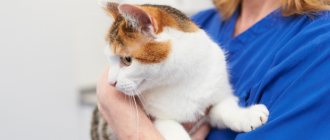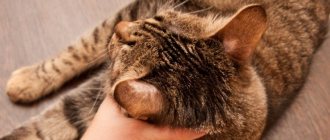Among all cat problems, a contagious disease that is caused by a group of scabies mites stands out. Parasites penetrate the skin, causing a lot of anxiety to the animal. Unpleasant symptoms accompanied by itching are only the visible part of the iceberg. Scabies in cats can have serious consequences. To eliminate the disease, it is necessary to diagnose the type of pathogen in time and treat the pet with prescribed medications.
Signs of the disease
global $ads_google; //data-ad-slot=”2475549904″ $ads_google = empty($ads_google) ? false : true; ?> if ($ads_google == false) {?>
$ads_google = true; ?> } ?>
Scabies in cats manifests itself with a whole range of symptoms. They begin to appear as the tick spreads across the animal's skin. As a rule, infection begins from the cat's head. Signs become apparent 5-7 days after infection. Thickened formations covered with crusts appear at the site of parasite penetration. Such plaques can be seen on the center line of the nose, at the base of the ears, along the eyebrows.
Further, the symptoms expand. The changes concern mainly the skin, but since they affect the pet’s well-being, behavior changes. The animal becomes irritable and even aggressive. The cat may refuse food, sleep poorly, and not participate in games. Common signs of scabies are:
- frequent scratching of the body and head;
- deterioration in wool quality and hair loss;
- formation of bald spots on the body;
- swelling of the lymph nodes;
- the appearance of white pustules;
- redness and suppuration of scratches;
- covering of the opened papules with scales.
The appearance of even one of the signs of scabies in a cat is a reason to consult a veterinarian.
How does notoedrosis manifest in cats?
Symptoms of notohedrosis are visible to the naked eye. Ticks begin to actively multiply on the cat’s scalp, so hair falls out on the pet’s face, around the eyes, ears, and on the forehead, and small blisters appear. Over time, they burst and bloody crusts appear in their place.
The animal actively itches, injures the affected areas, which leads to the formation of scratches, wounds, and then inflamed ulcers.
If left untreated, the mites spread further: first the skin on the chest suffers, then the abdomen is affected, after which the rest of the body is covered with crusts.
When notoedrosis is advanced, the animal’s immune system suffers. The temperature rises and the lymph nodes increase in size. Fungal skin diseases (trichophytosis, microsporia, candidiasis, etc.) are often associated.
At the initial stage of the disease, the animal begins to actively itch
Types and causes of the disease
Not all cats are susceptible to infection. This may be due to direct and indirect reasons. They relate to the physiological state of the animal, its care and a number of other circumstances. The development of scabies in cats is promoted by:
- decreased immunity;
- unsanitary conditions;
- lack of insecticidal treatment;
- kitten age up to two years;
- genetic predisposition.
Scabies mites are microscopic organisms; their sizes are measured in fractions of a millimeter. The shape, body length, and structural features depend on the biological species. This determines the type of disease. Various mites cause demodicosis, otodectosis, notoedrosis, and sarcoptic mange. In each case, its own specific symptoms are observed and adequate drug treatment is prescribed.
Demodicosis
The causative agent is the light gray Demodex canis mite. The parasite settles in hair follicles and sebaceous glands. Infection sometimes occurs in the newborn period. Affected areas may be small - up to 2.5 cm (localized form) or spread over most of the body (generalized form). The first one often goes away on its own.
Demodicosis manifests itself in the form of scaly redness or in the form of ulcers and ulcers. The generalized form of the disease often combines both symptoms. In this case, it is very difficult to treat the cat, as complications often arise.
global $ads_google; //data-ad-slot=”2475549904″ $ads_google = empty($ads_google) ? false : true; ?> if ($ads_google == false) {?>
$ads_google = true; ?> } ?>
Otodectosis
The ear mite Otodectes cynotis parasitizes the external and internal parts of the auricle. This type of disease is accompanied by the formation of scabs and scales on the surface of the auditory organ.
A strong putrid odor emanates from the affected area. Ear mange causes your cat to constantly scratch his head and especially his ears.
Notoedrosis
The disease, often called scabies, is caused by the Notoedres scabies mite. It has a round shape and gray color. This type of disease in cats affects the outer side of the ear. A gray liquid with an unpleasant odor accumulates in the affected areas.
Due to the discharge, the fur sticks together, later it begins to fall out and the pet’s head goes bald. In exposed areas, scales accumulate, forming scabs.
Sarcoptic mange
The causative agent of the disease is the yellowish or completely white mite Sarcoptes scabiei. The parasites first settle on the cat's face and then spread to the entire body. The diagnostic sign is the formation of red spots with thin gray lines with a nodule at the end. An inexperienced person may confuse sarcoptic mange with an allergy, since their symptoms are similar in appearance
Sarcoptic mange is dangerous due to bacterial infection and general sepsis.
How to make a diagnosis in veterinary clinics
The diagnosis of sarcoptic mange is made based on medical history, clinical signs compatible with the disease, microscopic examination of skin scrapings, and response to therapy. Response to therapy is sometimes used as a diagnostic test because sarcoptic mange mites can be very difficult to find on skin scrapings.
Your veterinarian will recommend the following:
- Superficial skin scrapings.
Most skin scrapings are positive for sarcoptic mange mites in less than 50 percent of cases. Scrapings should be superficial and cover the entire area of the skin lesion. The best areas for scrapings are the ears and elbows. Scrapings are never taken from areas of skin that the animal has scratched. Areas with thick crusts are also suitable for obtaining diagnostic material.
- Fecal flotation.
Mites can be found during a microscopic examination of the stool for parasites, as they are often ingested by a cat while biting its fur.
- Digestion of hair, crusts and scales in potassium hydroxide.
Soft organic elements dissolve in caustic potassium and after centrifugation, body parts of mites and their eggs can be found in the mass.
- Skin biopsy.
Occasionally, mites can be seen by microscopic examination of skin biopsy samples, but this method is not particularly sensitive. Papules are the best indications for biopsy.
Is scabies contagious to humans?
The question of whether scabies is transmitted to humans or not worries every owner of a fluffy cat. The disease is considered contagious and can spread to other animals and humans. These parasites cannot live outside a living organism; they definitely need a host. However, scabies mites, having penetrated the epidermis of human skin, cannot exist in it for a long time. Symptoms of infection with sarcoptic mange or notoedrosis look like an allergy. In rare cases, otodectosis can cause otitis externa.
global $ads_google; //data-ad-slot=”2475549904″ $ads_google = empty($ads_google) ? false : true; ?> if ($ads_google == false) {?>
$ads_google = true; ?> } ?>
Human skin is too dense for scabies mites; they cannot lay eggs in it or move around. This feature saves a person from cat scabies. In the short period while the ectoparasite is in the upper layers of the dermis, it causes itching and discomfort. After spontaneous healing, the symptoms disappear. Despite these features, when treating a sick cat, the owner must observe personal hygiene measures:
- use gloves when handling your pet;
- wash your hands with soap after treatment procedures;
- boil things that the cat has come into contact with;
- Regularly vacuum carpets and wash floors in the house.
Scabies mites disappear from the human body in less than a month.
Routes of infection
The most common route of infection with cat scabies is contact. The microscopic tick can easily jump from one infected animal to another. Moreover, it is absolutely not necessary to contact sick relatives. A cat can become infected from a dog, from another cat, or from birds - domestic or wild. Pigeons are especially prone to scabies.
This can happen anywhere: during a walk, at a veterinarian’s appointment, at an exhibition, on public transport. Small kittens often become infected from their sick mother during the period of cohabitation and feeding.
The second common route of transmission of parasites is through animal care items. You can pick up a tick from someone else's comb, brush, or bedding. The third is housekeeping clothes and shoes. A person can bring ticks into the house on their clothes or shoes.
Who is at risk
Most often people become infected with scabies:
- Animals with weakened immune systems.
- Exhausted cats.
- Pets in shelters and stray cats.
Diagnosis of scabies
If you suspect your cat has scabies, it is important to seek veterinary help promptly. The clinic will help make an accurate diagnosis and prescribe adequate treatment. Diagnostics includes an external examination of the animal and taking skin scrapings for microscopic analysis. This procedure is repeated two or three times to confirm the output. Based on the results, the doctor makes a conclusion about the cause of the problem. Often, a mite infestation can be confused with dermatitis, an allergic reaction, ringworm, or eczema. Therefore, a laboratory test is mandatory in the diagnostic system.
The duration of therapy is determined by the severity of the disease and the condition of the pet itself. The average treatment period for scabies ranges from one to four weeks. Medical care for a pet consists of injections, ointments, solutions, drops, and hygiene products with a therapeutic effect (shampoos, soaps). To eliminate scabies in cats, acaricides, antibiotics, antihistamines, antiseptics, and immunomodulators are used. To prevent the cat from licking the ointment applied to the surface of the skin, it is necessary to use a protective cap.
Diseases associated with disorders of the sebaceous glands
Acne in cats
While cats don't have to worry about prom, they suffer from acne just as much as humans. Typically, blackheads (acne) appear around the cat's chin. The cause may be stress, poor living conditions, a reaction to treatment, a hidden skin disease, or even a plastic bowl in which you pour your cat's food. If a bacterial infection accompanies acne, your veterinarian may recommend a specialized shampoo, gel, or antibiotic therapy. If your cat has a scattering of black dots on his chin, the first thing you need to do is change the bowls to ceramic or metal ones and wash them more often, this may be enough. In some cases, acne is complicated by a secondary bacterial infection, the cat begins to scratch its chin vigorously, hair comes out, and the cat’s skin becomes inflamed. in this case, be sure to contact a dermatologist to determine the cause of the disease; treatment is required.
“Greasy tail”
The syndrome, also called tail gland hyperplasia, indicates abnormally overactive sebaceous glands at the base of the tail. These glands create a waxy secretion that causes hair loss and a “greasy” appearance on the skin of the tail, especially at the base. In severe cases, a secondary bacterial infection may develop. Neutering can eliminate this problem in cats. Other treatment options include careful tail care and the use of special keratolytic shampoos.
Treatment of demodicosis
To help an adult cat or kitten, complex therapy is needed, including several drugs with different effects. You can treat your pet at home, but a treatment plan is developed by a veterinarian. If the disease is mild, then bathing with tar soap is sufficient to treat the animal. After this, sulfur ointment is applied to the affected areas or wiped with an infusion of medicinal herbs with anti-inflammatory and antiseptic effects (chamomile, calendula, string).
For a localized form, liquid medicine Tsipam, Ivermek, Amide, Ectodes, Perol is used. The product is applied to the lesion 1-2 times a week. These drugs are not used during pregnancy. When treating a generalized form of scabies, the cat's hair is first shaved off. Then the skin is treated with acaricidal preparations. At the same time, subcutaneous injections of Cydectin and antibiotics (Betamox, Amoxicillin or Camacidin) are given. Drops against fleas and ticks are applied to the withers (for example, Amit Forte).
Diagnosis of the disease and treatment
It is very important to exclude other diseases, the development of which is caused by subcutaneous mites (demodectosis, otodectosis).
To detect parasites, the veterinarian takes a scraping:
- The material is collected at the border of healthy and affected skin.
- The doctor carefully scrapes the skin with a scalpel or a special sharpened spoon until blood appears.
- The resulting particles are placed in a glass cup and filled with caustic soda (10% solution) for 3 minutes.
- After the material has softened, several small pieces are applied to a glass slide and examined under a microscope.
The diagnosis is made after pathogens are found in the scraping. Sometimes it is necessary to do this procedure again.
After making a diagnosis, the veterinarian writes a treatment regimen. First of all, an animal infected with a tick is isolated from other animals. In places covered with scabs, the wool is cut off. The crusts are carefully softened with chlorhexidine; in case of severe damage, you can wash the cat.
To confirm the diagnosis, a scraping is taken from the affected skin
First of all, it is necessary to destroy the pathogen. Antiparasitic parasites are used for this purpose. Stronghold is most effective for notoedrosis (it is dripped onto the withers twice, with a break of 4 weeks between treatments).
A day after applying the drops, aversectin ointment is applied to the areas of the skin damaged by the mite every 5 days (2-3 treatments in total). Wounds are also treated daily with sulfur ointment. Antihistamines are used to relieve itching.
How is otodectosis treated?
For ear scabies, the pet is prescribed medications with amitraz (Amitrazin, Tsipam), hexachlorane (Aurikan), as well as acaricides and insecticides (Neostomozan, Surolan, Ectodes, Aurikan, Dana). First, the surface of the auricle is cleaned with a cotton pad soaked in antiseptic. Then the liquid medicine is instilled. After this, the base of the ear is gently massaged so that the medicine is evenly distributed over the surface. For hygienic sanitation before treatment, you can use lotions and solutions:
- Otifri
- Otoklin
- Fitolar
- Furacilin
- Hydrogen peroxide
- Potassium permangantsovka
- Chlorhexidine
When treating scabies in cats, the medicine is instilled into both ears, regardless of the lesion.
The main causes of mange in cats
In addition to the direct impact of the parasite on the skin, other factors can also provoke disorders. The pathogen can remain on the skin of an infected animal for a long time without showing any signs or symptoms.
Parasites may not show any signs of life for a long time until the pet’s body gives up.
But in the presence of special provoking factors, the disease begins to manifest itself and becomes dangerous. These causes of scabies include:
- damage to the skin;
- skin diseases of any type;
- decreased immunity due to lack of nutrients;
- decreased immunity due to the presence or course of therapy for any disease;
- young age of the cat;
- predisposition to infection due to belonging to a specific breed;
- constant contact with infected animals.
At risk are individuals whose immunity is weakened for various reasons.
Attention! Most often, scabies appears in kittens and pets who have not yet reached two years of age. Pregnant and lactating individuals are also at risk due to reduced immunity. These groups of pets require special care, control and prevention.
Treatment of notohedrosis
Before using medications, it is necessary to remove hair from the outer part of the ears in the affected area. The second step is to bathe the cat with shampoo that contains acaricidal components. In the early stages, you can treat your pet with local remedies. Aversectin or novertine ointment is suitable for this; they are applied twice a week. An alternative may be Demos gel, the frequency of its use is once every four days.
global $ads_google; //data-ad-slot=”2475549904″ $ads_google = empty($ads_google) ? false : true; ?> if ($ads_google == false) {?>
$ads_google = true; ?> } ?>
For systemic treatment of feline scabies, injections of drugs based on ivermectin (1%) are prescribed - five injections every five days. The therapy includes Stronghold drops with selamectin or Advocate, they are used every three weeks.
Anti-itch medications that strengthen the immune system
These groups of medications are used regardless of the form of the disease and have a beneficial effect on the entire body. Antipruritics protect the skin from further scratching, which avoids or minimizes the consequences of secondary infection.
Immunoparasitan
It is a specially developed drug for the body's resistance to attack by parasites, including scabies mites. It is administered strictly intramuscularly. For individuals up to 5 kg, the dose is 0.1 ml of the active substance.
Thanks to the complex of lipoproteins and polysaccharides, the drug strengthens the immune system well
With greater body weight, the amount of Immunoparasitan can be increased to 0.2 ml. The exact number of injections is selected by the attending physician; an interval of 5 days is maintained between injections.
Maxidin
Normalizes hair growth, saturates the body with useful substances. Additionally, it enhances the effect of drugs against scabies mites of any type, and is especially effective against demodicosis. The dosage is selected taking into account the weight of the cat.
The main role of maxidin is to enhance the effect of other anti-parasitic drugs
With a weight of less than five kilograms, 0.5 ml is administered subcutaneously or intramuscularly, with a greater weight - 1 ml. The duration of treatment, taking into account the pet’s condition, is 3-5 days.
Clemastine
It is an antiallergic drug, but it also perfectly suppresses scabies. Use Clemastine in individually selected doses. The antihistamine dosage can be 0.5-1 mg/kg twice a day.
The duration of clemastine administration depends on the current condition of the cat.
Cyclosporine
A powerful antipruritic agent that simultaneously increases the body's resistance. It can cause severe diarrhea and new skin rashes in the animal; it is used only as directed by a doctor. The dose is 5 mg/kg of cat's body weight daily.
The course of treatment with cyclosporine is determined individually
Attention! Maxidin can also be used as eye or nasal drops; for this, purchase a solution with a concentration of 0.15%. In this form, the drug is instilled three times a day until complete recovery.
How is sarcoptic mange treated?
This type of disease requires treatment of the cat's entire body, so treatment at home is a labor-intensive but necessary process. As in other cases, it is necessary to remove hair so that ointments and solutions are more effectively distributed over the skin. Next, the cat is washed with tar soap or shampoo (Nizoral, TM Doctor).
For injections, acaricidal agents Ivermectin, Doramectin, Aversect are prescribed. For the treatment of sarcoptic mange, Sayfli tablets and local ointments Aversectin, Novertin, and Sulfur are intended. Preparations in solutions are also suitable for external use: Stomazan, Amit Forte, Amitrazine Plus. A choice of drops of coffee is dropped onto the withers of a sick cat: Lawyer, Stronghold, Fighter, Frontline.
Most anti-scab drugs are strong poisons that place increased stress on the liver. To support it, the cat needs hepatoprotectors.
What is scabies as a disease?
Scabies mites are parasites, representatives of arachnids , characterized by minimal sizes.
It looks like a small worm with short legs.
When a female arachnid lands on the skin of a person or animal, it penetrates under the stratum corneum, where larvae emerge from its eggs, and the next stage is adults.
Dangerous scabies mites feed on sebum ; as a result of their vital activity, the skin becomes inflamed, and even blood poisoning is possible. And the last form of the disease leads to a sad fatal outcome.
Scabies is usually diagnosed by professionals , although some types of mites crawling on the skin may be visible when examined under a microscope.
What are the possible consequences of scabies?
Areas affected by subcutaneous mites cause unbearable irritation in the cat. She combs the areas that bother her. Wounds and scratches are open gates for viral, bacterial and fungal infections. Pathogenic microorganisms cause inflammation. In severe situations, the outbreak festeres. In the absence of timely treatment of scabies and secondary infection, the cat may develop general sepsis.
Ticks, which lead an active lifestyle in the layers of the skin, secrete toxins. Toxic substances enter the blood and cause disturbances in the functioning of the central nervous system, heart, and lungs. With cat scabies, oxygen starvation is possible at the cellular level, which occurs due to metabolic disorders under the influence of harmful compounds.
Bacterial infections
In many cases, bacterial skin infections (pyoderma) develop as a result of other diseases. For example, acne can make a cat's hair follicles more vulnerable to infection, causing folliculitis. As a rule, in cats, bacterial inflammation of the skin is caused by staphylococcus, which in a healthy cat is part of the normal bacterial flora that lives on the skin and does not have a harmful effect, but when damaged (for example, during active scratching) causes inflammation. Therefore, for the development of bacterial inflammation , as a rule, there must be a primary pathology causing itching or other causes of skin damage. Bacterial infections can be treated with antibiotics, but the underlying cause must be addressed to avoid recurrence.
Preventive measures
To prevent infection with skin mites, it is necessary to remember and apply the rules of prevention. Firstly, if possible, it is advisable to protect your pet from contact with street animals. They often suffer from this contagious disease. Secondly, during routine insecticidal treatment it is periodically necessary to use selamectin-based products. It is enough to use such drugs once every six months. Thirdly, for hygiene procedures it is useful to use shampoos with insecticidal additives (for example, with tar).
At home, it is important to regularly carry out wet cleaning. A balanced cat diet also provides additional support. When you have enough minerals and vitamins in your diet, it is easier to keep your immune system healthy. It is also important to protect your pet from stress and hypothermia. A healthy, well-groomed cat is much less likely to be affected by subcutaneous mites and does not even pose a temporary threat to humans.
global $ads_google; //data-ad-slot=”2475549904″ $ads_google = empty($ads_google) ? false : true; ?> if ($ads_google == false) {?> $ads_google = true; ?> } ?>
What should the owner do if the cat is itching and licking?
Owners are usually alarmed if a domestic cat frequently licks and scratches itself. And such problems must be resolved immediately. Otherwise, the animal’s behavior will lead to the appearance of deep wounds and scratching. And they are dangerous due to the penetration of pathogenic fungi and bacteria.
There are many reasons for such symptoms. This means that looking for them on your own is pointless and even dangerous. In order not to waste time, the best solution is to contact a veterinarian.
Important! The maximum allowable help from the owners is to treat the pet for worms and fleas. If the animal continues to itch all the time, you need to contact a veterinarian.
General recommendations for eliminating the disease
You can speed up your pet’s recovery and protect others by following a number of recommendations:
- try to limit the cat in space so that it does not come into contact with other pets and your household;
- in addition to the main treatment, give vitamins and minerals that increase the body's resistance;
Don't forget to strengthen your pet's immunity with vitamin supplements
- if there are accompanying disorders in the form of suppuration, problems with nutrition, digestion, they should be eliminated at the same time as scabies;
- all items touched by the cat should be treated with special means or taken out into the cold, if the weather permits;
- since the cat will constantly try to lick itself, which can cause poisoning due to the ingestion of the active substances of the medications, you should put a restraint on the neck or constantly monitor the pet;
If you wish, you can make your pet's collar with your own hands.
- Do not apply different drugs to the patient’s body at the same time, as this may cause allergies or serious side effects;
- with combined local treatment, it is necessary to apply ointments, lotions, gels at intervals of 15-60 minutes; it is better to consult a veterinarian about this.











